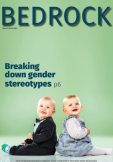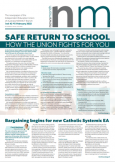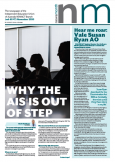
Co-principal Peter Fahey
However, Chalkley did end up being a principal, spending the final five years of his career sharing the role at St Peter’s Primary School.
“I’ve loved the aspect of sharing the role with Jenny Roberts. I’ve always seen myself as a team player so the idea of sharing the role was fantastic for me.
“It’s a model that we think would work in a lot of other schools. I think there’s a lot of people who are reluctant to take on a role on their own, but if they have an experienced mentor to help them for a couple of years, the transition can be a lot smoother. There are many people who would like to lead but they just need the encouragement of having someone walk alongside them.”
Walking together
Not far from Bendigo, at St James’ Parish School, Sebastopol, co-principals Garth Kydd and Peter Fahey have walked alongside each other as co-leaders.
Kydd says, “A shared role allows for the wellness of the leader.”
A healthy, coping leader can “connect deeply with all aspects of the school environment” and help maintain the wellbeing of the school community.
Kydd says shared leadership “allows for change to happen more effectively, for voices to be shared more openly, and for decisions to follow a far more rigorous and timely discernment process”.
He was partly inspired to give shared leadership a go because of a “transformative leadership shift” at a previous school.
A lone principal who had been “shouldering the strain of the system and community”, became unwell.
“This was a period where shame and isolation were prevalent,” Kydd says.
However, when two principals took on the leadership responsibility, there was “positive change”.
“What resonated with me was the value of perspective. This model allowed for change to happen more effectively, for voices to be shared more openly, and for decisions to be made that followed a far more rigorous and timely process of discernment. As an emerging leader, I felt this model was perfect for developing my leadership skills.”
Kydd’s co-leader, Peter Fahey, believes few individuals possess all the expertise necessary to effectively address his school community’s diverse challenges. Shared leadership offers a “compelling opportunity to partner with another experienced educator, leverage complementary strengths, and collectively lead our school towards sustained improvement and excellence,” Fahey says.
Fahey began his journey into co-principalship with a “deep-seated belief in the power of collaborative leadership”, having reached a point in his career where he aspired to expand his impact “beyond the confines of a traditional administrative role”.
“Educational leadership today requires navigating many challenges, from fostering inclusive school cultures to managing rigorous academic standards and integrating technology effectively,” Fahey says.
“I saw co-principalship as a strategic approach to distribute leadership responsibilities more equitably, enhancing our capacity to innovate, adapt, and meet the evolving needs of our students, staff, and stakeholders.”
On a personal level, co-principalship offered Fahey “a pathway for continuous professional growth and development”.
“By sharing the job with a trusted colleague, I envisioned opportunities for mentorship, mutual learning, and collaborative problem-solving. Co-principalship broadened my leadership skills, expanded my support network, and I gained fresh perspectives on educational leadership practices.”
Fahey specialises in instructional leadership, curriculum development, and staff support, while Kydd excels in organisational management, community relations, and strategic planning.
Fahey outlined the following advantages of shared leadership:
Shared decision-making and problem-solving
Regular dialogue, consultation with stakeholders, and joint deliberation on critical decisions ensure that diverse perspectives inform decisions, align with the school’s mission and values, and prioritise the best interests of their students.
Continuity and stability
In absences, transitions, or unforeseen challenges, co-principals can coordinate their efforts to maintain operational continuity, uphold established policies and procedures, and sustain momentum towards strategic goals.














































































































































